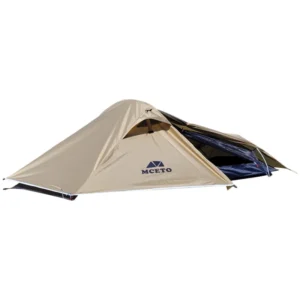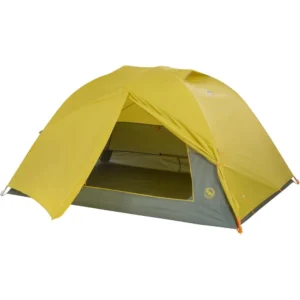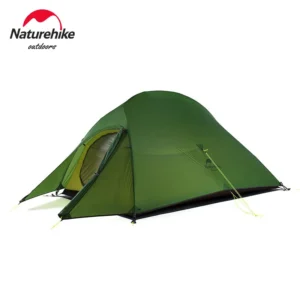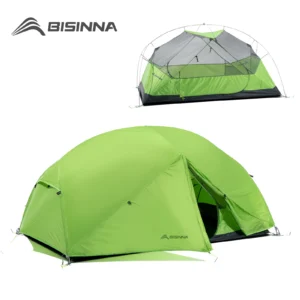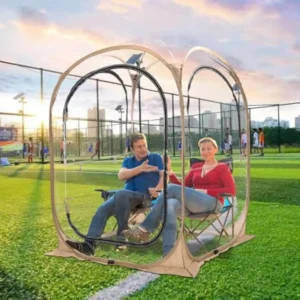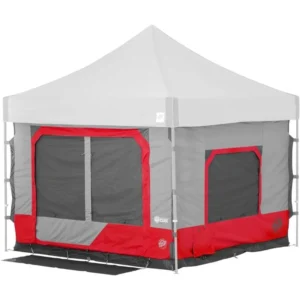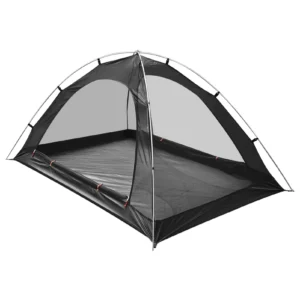Ultralight Freestanding Tent
Lighten your pack with an ultralight freestanding tent. Set up camp quickly on any surface, from rocky patches to wooden platforms, for easier adventures.

Showing all 5 results
Heavy Duty 4 Season Tent, Ultralight Freestanding Tent, Winter Camping Tent
$3,722.66 Select options This product has multiple variants. The options may be chosen on the product pageHeavy Duty 4 Season Tent, Lightweight Backpacking Tent, Ultralight Backpacking Tent, Ultralight Freestanding Tent
Price range: $106.68 through $381.84 Select options This product has multiple variants. The options may be chosen on the product pageBackpacking Tent with Vestibule, Lightweight Backpacking Tent, Ultralight Backpacking Tent, Ultralight Freestanding Tent
$682.75 Select options This product has multiple variants. The options may be chosen on the product pageFreestanding Backpacking Tent, Lightweight Backpacking Tent, Ultralight Backpacking Tent, Ultralight Freestanding Tent
Price range: $734.57 through $808.01 Select options This product has multiple variants. The options may be chosen on the product pageBackpacking Tent with Vestibule, Lightweight Backpacking Tent, Ultralight Backpacking Tent, Ultralight Freestanding Tent
Price range: $463.05 through $470.70 Select options This product has multiple variants. The options may be chosen on the product page
Showing all 5 results
What Makes a Tent Truly “Ultralight” and “Freestanding”?
Definition Box:
An ultralight tent weighs under 3 pounds (1.4 kg), often pushing 2 pounds (0.9 kg) or less. A freestanding tent can stand without stakes but should still be staked for stability. “Minimum trail weight” refers to just poles, rainfly and tent body, while “packed weight” includes all components.
Creating an ultralight freestanding tent represents one of the greatest engineering challenges in outdoor gear design. While traditional backpacking tents often weigh 4-5 pounds (1.8-2.3 kg), ultralight models significantly reduce this burden through innovative materials and structural designs.
The engineering challenge comes from the competing demands: freestanding tents require a complete pole structure to support themselves without stakes, adding weight that ultralight designs aim to eliminate. This delicate balance between structural integrity and weight reduction requires sophisticated materials and careful design compromises.
Unlike ultralight backpacking tents that may rely on trekking poles or complex staking arrangements, these shelters provide the convenience of quick setup with the benefit of minimal pack weight.
The Perfect Balance: Key Advantages of Ultralight Freestanding Shelters
The combination of minimal weight and structural independence creates several compelling benefits:
Reduced Pack Weight – Carrying less weight means less fatigue over long distances, allowing hikers to cover more ground with less effort. A 2-pound tent versus a 5-pound tent represents significant energy savings over a multi-day trip.
Setup Versatility – Freestanding designs excel on challenging surfaces like solid rock, wooden platforms, or sandy beaches where stakes may be difficult or impossible to use effectively, making them more adaptable than trekking pole backpacking tents.
Easy Repositioning – Once pitched, you can lift and move the entire tent to find the perfect spot without repeating the full setup process. This proves invaluable when discovering a rock under your sleeping area or needing to adjust for changing weather conditions.
Enhanced Ventilation – The pole structures in freestanding designs often create more interior volume and better airflow pathways, especially in double-wall configurations that separate the sleeping area from the rainfly.
Quick Setup and Breakdown – When storms approach or when breaking camp in the morning, the ability to quickly assemble or disassemble your shelter without complex staking arrangements saves precious time.
Understanding the Trade-offs: What You Might Sacrifice
Key Considerations:
Ultralight freestanding tents typically cost 30-50% more than their conventional counterparts and often use thinner materials (10-20 denier versus 30-70 denier in standard tents).
While these tents offer remarkable advantages, they come with important compromises. The most immediate is price—the specialized materials and engineering required command a premium. The ultralight fabrics necessary to achieve these weight targets also tend to be more delicate, requiring greater care to prevent tears and punctures.
Interior space often becomes another casualty of weight reduction. Many ultralight freestanding tents feature more tapered designs, lower peak heights, and less generous floor dimensions than their heavier counterparts. The concept of “semi-freestanding” represents a common compromise, where most of the tent stands independently but corners or vestibules still require stakes for proper tension.
Weather performance can also vary significantly. While premium ultralight tents from quality brands like those at Explore Elements perform admirably in challenging conditions, the reduced material weight sometimes results in more movement during high winds compared to heavier expedition tents.
Essential Factors: How to Choose Your Ideal Shelter
Weight Classification
The true weight of your tent depends on how you’ll carry it. Minimum trail weight includes only the essentials (poles, fly, body), while packed weight includes everything (stakes, stuff sacks, repair items). Consider how you might share components among hiking partners to distribute weight efficiently.
Capacity and Livability
Manufacturer capacity ratings often represent the maximum occupancy rather than optimal comfort. A “2-person” ultralight tent typically offers a snug fit for two average adults with minimal gear inside. Consider:
– Floor dimensions and shape (tapered designs save weight but reduce usable space)
– Peak height (affects sitting and changing clothes)
– Door configuration (single vs. dual entry)
– Vestibule size for gear storage
Material Durability
Ultralight tents typically use fabrics with lower denier ratings:
– 7-15 denier for tent floors and rainflies in the lightest options
– 15-30 denier for more durable ultralight models
– 30-70 denier in standard backpacking tents
Materials like Dyneema Composite Fabric (formerly Cuben Fiber) offer exceptional strength-to-weight ratios but at premium prices, while silicone-treated nylon (silnylon) and polyester (silpoly) provide more affordable ultralight options with varying performance characteristics.
Weather Protection
Consider the conditions you’ll face most often. Full-coverage rainflies, adequate ventilation, and quality seam-sealing significantly impact performance in wet conditions. Pole structure design affects stability in wind, with crossed poles generally providing better resistance than single-hoop designs.
Single-Wall vs. Double-Wall: Making the Right Choice
| Feature | Single-Wall | Double-Wall |
|---|---|---|
| Weight | Lighter (15-30% less) | Heavier |
| Condensation | More prone to internal moisture | Better moisture management |
| Setup | Simpler, one-piece design | More components, typically more steps |
| Versatility | Fixed configuration | Can often pitch fly-only or inner-only |
Single-wall tents combine the rainfly and tent body into one integrated structure, saving significant weight but often struggling with condensation management. The physics of warm air meeting cold surfaces means moisture forms inside when temperatures drop, potentially dripping onto occupants and gear.
Double-wall designs separate these layers, creating an air gap that allows moisture to escape through the breathable inner tent before condensing on the waterproof fly. This design weighs more but typically provides a more comfortable experience in varied conditions.
Understanding Freestanding Variations: Full vs. Semi
Fully freestanding backpacking tents stand completely on their own once poles are inserted, with the floor, walls, and vestibules (if present) all maintaining their shape without stakes. These provide maximum flexibility for setup locations but typically weigh more due to the comprehensive pole structure.
Semi-freestanding tents represent a common middle ground, where the main living area stands independently, but certain features—usually vestibules or floor corners—require staking for proper tension. This design reduces weight while retaining most freestanding benefits. When shopping, carefully read descriptions to understand which category a tent truly falls into.
Top Ultralight Freestanding Tent Categories of 2025
Today’s market offers several distinct categories within the ultralight freestanding realm:
- Full-Featured Ultralight Models balance weight savings with comfort features like dual doors, adequate headroom, and storage pockets while staying under 3 pounds (1.4 kg)
- Minimalist Designs push weight boundaries below 2 pounds (0.9 kg) by reducing features and interior space
- Semi-Freestanding Compromises offer excellent weight-to-livability ratios by requiring minimal staking
- Value-Oriented Options use slightly heavier materials to reduce cost while maintaining reasonable pack weights
- Weather Specialists prioritize ventilation for hot climates or stability for alpine conditions
The Explore Elements collection features carefully selected options across these categories, each tested in real-world conditions to ensure performance matches specifications.
Maximizing Lifespan: Care Guidelines for Ultralight Materials
Ultralight tents require special care to ensure longevity:
- Clean with gentle soap and water only, avoiding harsh chemicals
- Always dry completely before storage to prevent mildew
- Store loosely in a cool, dry place rather than compressed in stuff sacks
- Use a groundsheet or footprint to protect thin floor materials
- Avoid excessive UV exposure, which degrades even the highest-quality fabrics
- Apply seam sealer annually or when water repellency diminishes
- Address small tears immediately with appropriate repair tape
Overcoming Common Challenges with Ultralight Shelters
Managing Condensation
Strategic site selection away from water sources and proper ventilation management can dramatically reduce condensation. In humid conditions, keep vents open and avoid touching interior surfaces during the night.
Protecting Fragile Materials
Using a footprint, clearing your tent site of sharp objects, and being mindful of zippers and pole connections helps preserve ultralight fabrics. Consider packing a small repair kit for field fixes.
Enhancing Wind Stability
Even freestanding tents benefit from proper staking in windy conditions. Orient the tent with the narrowest profile facing prevailing winds, and use all included guylines to maximize stability.
Adapting to Limited Space
Organizational discipline becomes essential in smaller shelters. Use stuff sacks to compress clothing, keep necessary items accessible in tent pockets, and store remaining gear in vestibules when available.
Is an Ultralight Freestanding Tent Right for Your Adventures?
Ultralight freestanding tents excel for backpacking trips where every ounce matters but you still face variable terrain. They’re ideal for through-hikers, weekend backpackers covering significant distances, and travelers who value flexibility and quick setup.
However, if you primarily car camp, prioritize interior space, or regularly face extreme weather like winter conditions (where winter camping tents may be more appropriate), the weight savings may not justify the compromises in durability and features.
Your experience level also matters—newer backpackers might appreciate the forgiveness of a freestanding design while learning shelter management skills, while ultralight enthusiasts might eventually migrate toward even lighter non-freestanding options as their techniques refine.
Your Ultralight Tent Questions Answered
Can ultralight tents handle harsh weather?
Quality ultralight tents can handle most three-season conditions, including rain and moderate wind. However, they typically offer less protection than heavier winter camping tents designed specifically for extreme conditions.
What’s considered a “good” weight for an ultralight freestanding tent?
For a 2-person model, under 3 pounds (1.4 kg) packed weight is excellent, with premium models pushing below 2.5 pounds (1.1 kg). Single-person versions often achieve under 2 pounds (0.9 kg).
How do ultralight materials compare in durability?
While ultralight fabrics are inevitably more delicate than heavier alternatives, modern materials offer impressive strength-to-weight ratios. With proper care, quality ultralight tents can last for thousands of miles of use.
What are the main ultralight tent material categories?
The primary options include Dyneema Composite Fabric (extremely lightweight, waterproof, expensive), silnylon (lightweight, stretches when wet), silpoly (lightweight, minimal stretching when wet), and various proprietary fabrics that balance these characteristics.
Is a footprint necessary with ultralight tents?
While not strictly necessary, a footprint significantly extends the lifespan of thin tent floors and adds minimal weight to your pack. Many ultralight backpackers consider this weight penalty worth the protection it provides.


